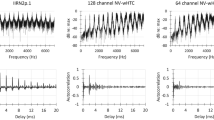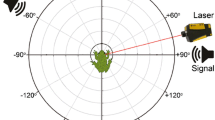Summary
-
1.
Frequency selectivity of hearing was measured in the green treefrog,Hyla cinerea. A psychophysical technique based on reflex modification was used to obtain masked threshold estimates for pure tones (300–5,400 Hz) presented against two levels of broadband masking noise. A pure tone (S-1) presented 200 ms prior to a reflex-eliciting stimulus (S-2) inhibited the motor reflex response to S-2. The magnitude of this reflex modification effect varied systematically with the sound pressure level (SPL) of S-1, and threshold was defined as the SPL of S-1 at which the reflex modification effect disappeared.
-
2.
Masked thresholds were used to calculate critical ratios, an index of the auditory system's frequency selectivity. The frequency selectivity of the treefrog's hearing is greatest and critical ratios are lowest (22–24 dB) at about 900 and 3,000 Hz, the two spectral regions dominant in the male treefrog's species-specific advertisement call. These results suggest that the treefrog's auditory system may be specialized to reject noise at biologically relevant frequencies.
-
3.
As in other vertebrates, critical ratios remain constant when background noise level is varied; however, the shape of the treefrog's critical ratio function across frequencies differs from the typical vertebrate function that increases with increasing frequency at a slope of about 3 dB/octave. Instead, the treefrog's critical ratio function resembles its pure tone audiogram. Although the shape of the treefrog's critical ratio function is atypical, the critical ratio values themselves are comparable to those of many other vertebrates in the same frequency range.
-
4.
Critical ratio values here measured behaviorally do not match critical ratio values previously measured physiologically in single eighth nerve fibers. This suggests that frequency selectivity of hearing in the green treefrog is mediated in the central, rather than the peripheral, auditory system and probably does not arise directly from the tuning of the individual auditory nerve fibers.
Similar content being viewed by others
References
Blair WF (1963) Acoustic behavior of amphibia. In: Busnel RG (ed) Acoustic behavior of animals. Elsevier, New York, pp 694–708
Bogert CM (1960) The influence of sound on the behavior of amphibians and reptiles. In: Lanyon WE, Tavolga WN (eds) Animal sounds and communication. DC: Am Inst Biol Science, Washington, pp 137–320
Capranica RR (1976) Morphology and physiology of the auditory system. In: Llinas R, Precht W (eds) Frog neurobiology. Springer, Berlin Heidelberg New York, pp 551–575
Capranica RR, Moffat AJM (1977) Place mechanism underlying frequency analysis in the toad's inner ear. J Acoust Soc Am [Suppl] 62:S36
Capranica RR, Moffat AJM (1980) Nonlinear properties of the peripheral auditory system of anurans. In: Popper AN, Fay RR (eds) Comparative studies of hearing in vertebrates. Springer, Berlin Heidelberg New York, pp 139–165
Capranica RR, Moffat AJM (1983) Neurobehavioral correlates of sound communication in anurans. In: Ewert JP, Capranica RR, Ingle DJ (eds) Advances in vertebrate neuroethology. Plenum Press, New York, pp 701–730
Costalupes JA (1983) Broadband masking noise and behavioral pure tone thresholds in cats. J Acoust Soc Am 74: 758–764
Dooling RJ, Saunders JC (1975) Hearing in the parakeet (Melopsittacus undulatus): Absolute thresholds, critical ratios, frequency difference limens and vocalizations. J Comp Physiol Psychol 88:1–20
Ehret G (1975) Masked auditory thresholds, critical ratios, and scales of the basilar membrane of the housemouse (Mus musculus). J Comp Physiol 103:329–341
Ehret G, Capranica RR (1980) Masking patterns and filter characteristics of auditory nerve fibers in the green treefrog (Hyla cinerea). J Comp Physiol 141:1–12
Ehret G, Gerhardt HC (1980) Auditory masking and effects of noise on responses of the green treefrog (Hyla cinerea) to synthetic mating calls. J Comp Physiol 141:13–18
Ehret G, Merzenich MM (1985) Auditory midbrain responses parallel spectral integration phenomena. Science 227:1245–1247
Fay RR (1974) Masking of tones by noise for the goldfish (Carassius auratus). J Comp Physiol Psychol 87:708–716
Fay RR (1978) Phase locking in goldfish saccular nerve fibers accounts for frequency discrimination capacities. Nature 275:320–322
Fay RR, Coombs S (1983) Neural mechanisms in sound detection and temporal summation. Hearing Res 10:69–92
Feng AS (1980) Directional characteristics of the acoustic receiver of the leopard frog (Rana pipiens): A study of eighth nerve auditory responses. J Acoust Soc Am 68:1107–1113
Fletcher H (1940) Auditory patterns. Rev Mod Phys 12:47–65
Gerhardt HC (1974) The significance of some spectral features in mating call recognition in the green treefrog,Hyla cinerea. J Exp Biol 61:229–241
Gourevitch G (1965) Auditory masking in the rat. J Acoust Soc Am 37:439–443
Greenwood DD (1961) Critical bandwidth and the frequency coordinates of the basilar membrane. J Acoust Soc Am 33:1344–1356
Hawkins AD, Chapman CJ (1975) Masked auditory thresholds in the cod,Gadus morhua L. J Comp Physiol 103:209–226
Hawkins J, Stevens S (1950) The masking of pure tones and of speech by white noise. J Acoust Soc Am 22:6–13
Hillery CM, Narins PM (1984) Neurophysiological evidence for a travelling wave in the amphibian inner ear. Science 225:1037–1039
Hoffman HS, Ison JR (1980) Reflex modification in the domain of startle: I. Some empirical findings and their implications for how the nervous system processes sensory input. Psychol Rev 87:175–189
Lewis ER, Leverenz EL, Koyama H (1982) The tonotopic organization of the bullfrog amphibian papilla, an auditory organ lacking a basilar membrane. J Comp Physiol 145:437–445
Liberman MC (1982) The cochlear frequency map for the cat: Labeling auditory-nerve fibers of known characteristic frequency. J Acoust Sóc Am 72:1441–1449
Long GR (1977) Masked auditory thresholds from the bat,Rhinolophus ferrumequinum. J Comp Physiol 116: 247–255
Megela-Simmons A, Moss CF, Daniel KM (1985) Behavioral audiograms of the bullfrog (Rana catesbeiana) and the green treefrog (Hyla cinerea). J Acoust Soc Am 78: 1236–1244
Miller JD (1964) Auditory sensitivity of the chinchilla. J Acoust Soc Am 36:2010
Narins PM (1982) Effects of masking noise on evoked calling in the Puerto Rican Coqui (Anura: Leptodactylidae). J Comp Physiol 147:439–446
Pickles JO (1975) Normal critical bands in the cat. Acta Otolaryngol 80:245–254
Pickles JO, Comis SD (1976) Auditory-nerve fiber bandwidths and critical bandwidths in the cat. J Acoust Soc Am 60:1151–1156
Saunders JC, Denny RM, Bock GR (1978) Critical bands in the parakeet (Melopsittacus undulatus). J Comp Physiol 125:359–365
Scharf B (1970) Critical bands. In: Tobias JV (ed) Foundations of modern auditory theory. Academic Press, New York, pp 159–202
Watson C (1963) Masking of tones by noise for the cat. J Acoust Soc Am 35:167–172
Young JS, Fechter LD (1983) Reflex inhibition procedures for animal audiometry: A technique for assessing ototoxicity. J Acoust Soc Am 73:1686–1693
Zwicker E, Flottorp G, Stevens S (1957) Critical bandwidths in loudness summation. J Acoust Soc Am 29:548–557
Author information
Authors and Affiliations
Rights and permissions
About this article
Cite this article
Moss, C.F., Simmons, A.M. Frequency selectivity of hearing in the green treefrog,Hyla cinerea . J. Comp. Physiol. 159, 257–266 (1986). https://doi.org/10.1007/BF00612308
Accepted:
Issue Date:
DOI: https://doi.org/10.1007/BF00612308




